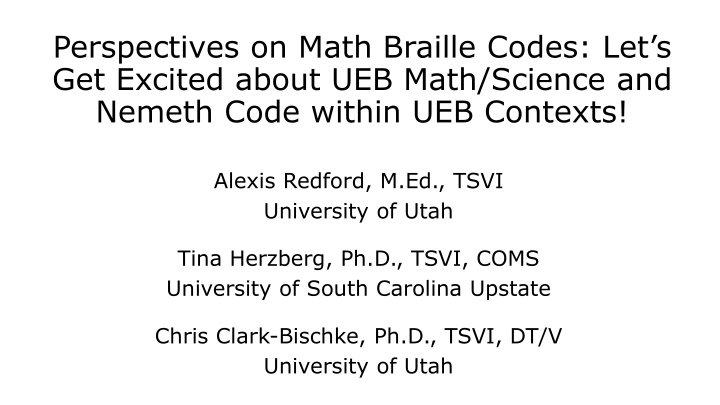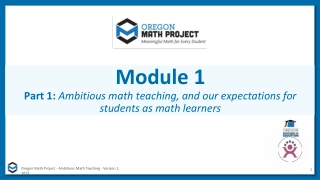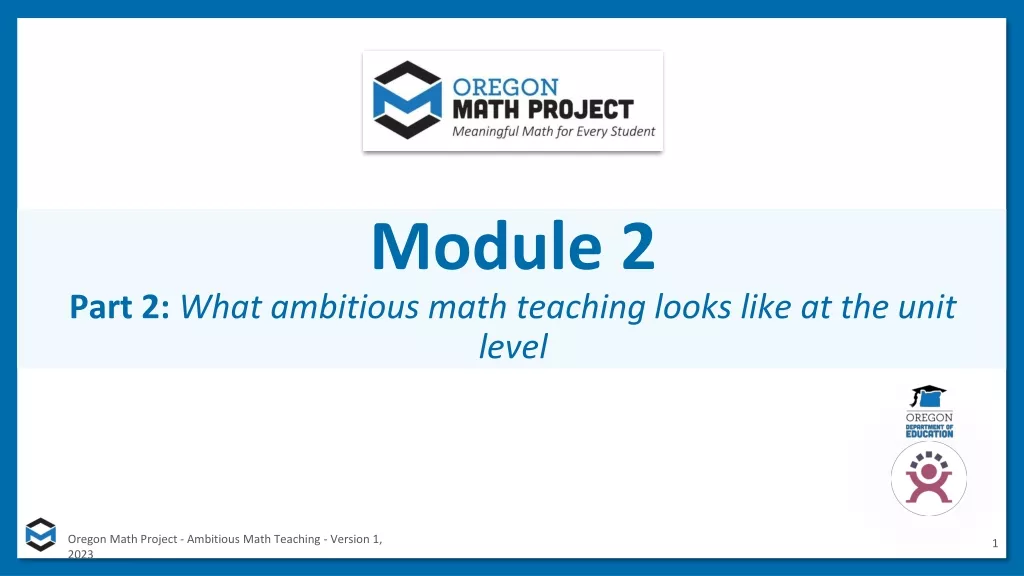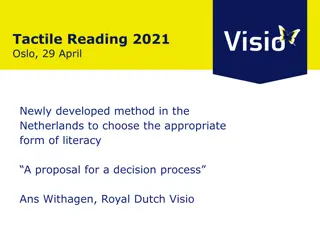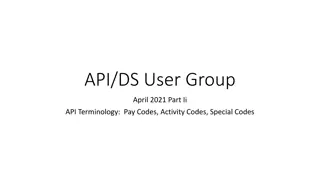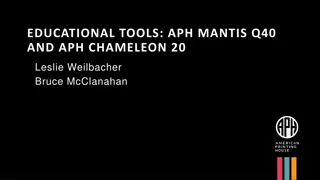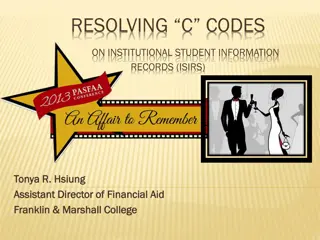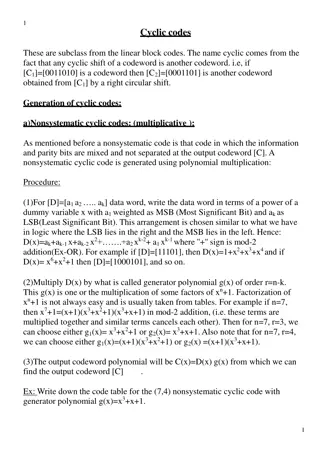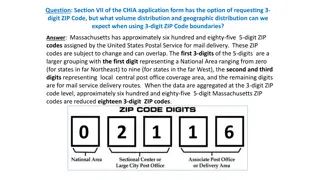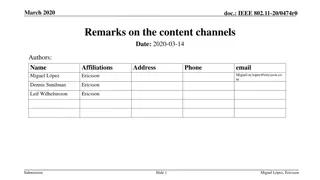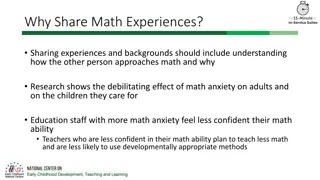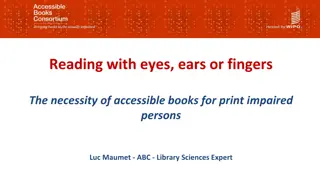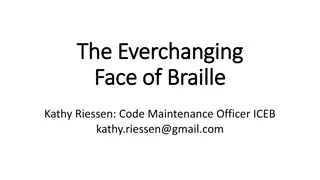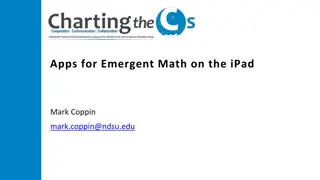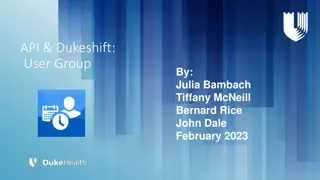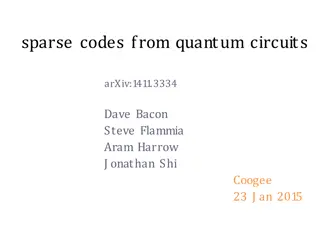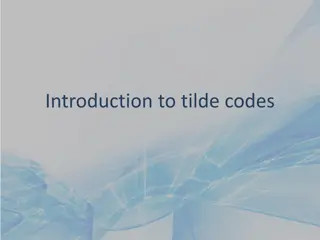Perspectives on Math Braille Codes: Strategies and Resources for Teaching UEB Math/Science
This content explores the results of a survey on math braille codes, identifying strategies and resources for teaching Nemeth Code within UEB contexts and UEB Math/Science to braille-reading students. It delves into survey data, participant insights, competency levels, factors influencing curriculum, and barriers to teaching UEB Math/Science.
Download Presentation

Please find below an Image/Link to download the presentation.
The content on the website is provided AS IS for your information and personal use only. It may not be sold, licensed, or shared on other websites without obtaining consent from the author.If you encounter any issues during the download, it is possible that the publisher has removed the file from their server.
You are allowed to download the files provided on this website for personal or commercial use, subject to the condition that they are used lawfully. All files are the property of their respective owners.
The content on the website is provided AS IS for your information and personal use only. It may not be sold, licensed, or shared on other websites without obtaining consent from the author.
E N D
Presentation Transcript
Perspectives on Math Braille Codes: Lets Get Excited about UEB Math/Science and Nemeth Code within UEB Contexts! Alexis Redford, M.Ed., TSVI University of Utah Tina Herzberg, Ph.D., TSVI, COMS University of South Carolina Upstate Chris Clark-Bischke, Ph.D., TSVI, DT/V University of Utah
Objectives Participants will be able to: 1. Describe the results of the survey completed by 176 TSVIs. 2. Identify three strategies and resources that can be used to teach Nemeth Code within UEB Contexts to students who read braille. 3. Identify three strategies and resources that can be used to teach UEB Math/Science to students who read braille.
Survey Participants 176 TSVIs from 36 geographically diverse states States with the most responses included California (n=14), Georgia (n=13), Florida (n=12), and Indiana (n=11). Participants learned math braille codes in a variety of ways. 107 participants indicated that their state has a default code. Nemeth Code (n=86) UEB Math/Science (n=27)
UEB Math/Science Competency Level Advanced, 13 Intermediate, 37 Beginner, 67 I do not know UEB Math/Science, 32 Did not respond, 27 5
Nemeth Code Competency Level Advanced, 32 Intermediate, 63 Beginner, 43 I do not know UEB Math/Science, 11 Did not respond, 27 6
Factors That Influence Math Braille Code Taught Curriculum (n=36) Textbooks and/or test availability (n=36) State default braille code (n=35) Age of student (n=32) Individualized Education Plan (IEP) team decision (n=31) Teacher knowledge and experience (n=30) Students personal preference (n=30) Teachers personal preference (n=11) Parent s personal preference (n=10) Outside influence (n=10) Other (n=10)
Barriers to Teaching UEB Math/Science TSVI doesn't teach/know UEB Math/Science (n=37) The fact that we have two math braille codes in the US (n=8) Tests, textbooks, and materials not being embossed/available in UEB Math/Science (n=34) Incorrect rumors and biases against UEB Math/Science amongst professionals (n=7) TSVIs personal preference for Nemeth Code (n=12) No barriers perceived (n=7) Students preference for which math code they use (n=6) Need additional training for TSVIs (n=11) Issues with UEB Math/Science (BrailleSense, etc.) (n=6)
Barriers to Teaching UEB Math/Science (continued) Students transitioning from one TSVI to another TSVI and the varied knowledge of TSVIs in UEB Math/Science may impact student performance (n=2) Parent preference for which math code is taught (n=1) TSVI only teaches UEB Math/Science through elementary, then switches to Nemeth Code (n=1) UEB Math/Science is difficult for TSVIs and students to learn (n=6) The time it takes to teach UEB Math/Science (n=5) TSVIs confidence in ability to teach UEB Math/Science (n=3) Students who have to transition from Nemeth Code to UEB Math/Science (n=3) Lack of UEB Math/Science materials and resources (n=3)
Barriers to Teaching to Nemeth Code TSVI does not know/teach Nemeth Code (n=45) Code switching (n=31) Tests, textbooks, and materials not being embossed/available in Nemeth Code (n=18) Need more training and resources for TSVIs (n=9) Issues with refreshable braille displays accurately displaying Nemeth (n=3) Time (for TSVIs to teach Nemeth Code, acquire materials, etc.) (n=3) TSVI doesn t have a math background, making it difficult to support students (n=2)
Barriers to Teaching to Nemeth Code (continued) Many students come in knowing UEB Math/Science and I (TSVI) have to transition them to Nemeth (for advanced mathematics) (n=2) Student preference on which math code to learn (n=2) Support from other professionals (n=2) TSVI s preferences (n=1) Misinformation about the two math codes and which is better (n=1) Expense of textbooks (n=1)
Resources and Strategies for Teaching UEB Math/Science
UEB Math/Science Codebooks and Guidelines The Rules of Unified English Braille, 3rd Edition, 2024 (print & braille editions) Provisional Guidance on Transcribing Mathematics in UEB, 2019 Graphing Calculator Guidelines Guidance for Transcription Using UEB, 2024
UEB Math/Science Codebooks and Guidelines (continued) Unified English Braille Guidelines for Technical Material 2014 (print & braille editions) (International Council on English Braille) ICEB is working on a 2nd edition. Section 3: Signs of Operation and Comparison was updated in 2018.
UEB Math/Science Resource The Hitchhiker s Guide to UEB
UEB Math/Science Online Resources APH UEB Math Reference Booklet (print and braille) APH UEB Math Tutorial UEB Online Canadian National Institute for the Blind (CNIB) UEB Technical Course
UEB Math/Science Resources from the National Braille Association UEB Math/Science Reference Sheets(print and braille versions) Using UEB in Technical Materials (digital print, hardcopy print, and braille versions) Grade 1 and Capital Indicators (digital print, hardcopy print, and braille versions) UEB Technical: Algebra and Geometry Basic (print)
UEB Math/Science Resources from APH Math Drill Cards in Braille and Large Print: Addition Facts in UEB Math Drill Cards in Braille and Large Print: Subtraction Facts in UEB
UEB Math/Science Resources from APH (continued) Feel n Peel Stickers UEB Print/Braille Numbers Flip Over Concept Books Telling Time Flip Over Concept Books - Fractions
Resources and Strategies for Teaching the Nemeth Code within UEB Contexts
Nemeth Code within UEB Contexts Codebooks and Guidelines from BANA The Nemeth Braille Code for Mathematics and Science Notation, 2022 (print and braille) Graphing Calculator Guidelines, April 2018 Chemical Notation Using the Nemeth Braille Code, 2023
Nemeth Code within UEB Contexts Resources Learning and Teaching the Nemeth Code within UEB Contexts: A Step-by-Step Guide Designed to support you as you learn the Nemeth Code. Throughout the book, you will also view real life examples of STEM materials transcribed into braille. Teaching strategies have been embedded. All materials in both print and braille.
Nemeth Code within UEB Contexts Online Resources APH Nemeth Tutorial APH Math Symbols Reference Booklet (print and braille)
Nemeth Code within UEB Contexts Other Resources Nemeth at a Glance: A Math Resource, Grade Level Chart, and Evaluation Tool, February 2017, TSBVI Nemeth Reference Sheets from the National Braille Press (print and braille versions)
Paths to Literacy Resource Nemeth Braille Code Curriculum 25
Nemeth Braille Code Curriculum (Pre-K through 2nd Grade) Teaches students to read and write Nemeth Code within UEB Contexts Pre-K, kindergarten, first grade, and second grade materials Aligned with the Common Core State Standards (CCSS Initiative, 2010) Hands-on games and activities Includes teacher scripts, braille ready files for student worksheets, answer keys, data recording sheets, review activities, and assessments
Focused Nemeth Lessons Students of any age may enjoy and learn from the lessons, especially if they need additional practice. Five-Step Rule and Exceptions Fractions and Mixed Numbers Multiplication and Division Number Lines Radical Expressions
Paths to Literacy Resource Nemeth Symbol Library Page 30
Nemeth Symbol Library Began with higher grade levels Has extended down through all grade levels Incorporates over 600 examples at different grade levels Includes tutorial and list of commands used to access library Contains 240 terms, 136 definitions
Nemeth Code within UEB Contexts Resources from APH Math Drill Cards in Braille and Large Print: Addition Cards Math Drill Cards in Braille and Large Print: Subtraction Cards Quick Pick Math: Addition Quick Pick Math: Subtraction Addition and Subtraction Table
Other Resources for Use within UEB Math/Science and Nemeth Code within UEB Contexts
Pre-Kindergarten Building a Train Materials Foam stickers Craft sticks Flash cards labeled 1- 7 Steps Student shuffles flash cards Student draws a card and reads the numeral on the card Student uses stickers to build the train
More Curriculum Materials Roll and Race Game Cards Templates for BINGO cards Shapes Activity Connect Four Game Cards and Problem Sets Counting to 120 Chart Place Value Chart While many of these are available only in Nemeth Code, they can be easily modified or created using UEB Math/Science.
Nemeth in a Box (Mathlete Competition Coming Spring 2025!) Teaches Nemeth Code symbols in math context through puzzles and games that challenge students and build their reasoning skills. Materials available online in print and braille from Project INSPIRE 2.
Hands-on Materials and Manipulatives from APH DRAFTSMAN: Tactile Drawing Board TactileDoodle Tactile Five and Ten Frames 38
More Hands-on Materials and Manipulatives Geometry Tactile Graphics Kit (APH) Has both early and more advanced concepts Includes common graphics used in geometry class Math Window magnetic tiles Available in UEB Math/Science and Nemeth Code within UEB Contexts
Rounding Decimals Fifth grade skill The APH Number Line Device works well for teaching students to round decimals. Wikki Stix can be used to mark on the APH Number Line Device.
Graphing Graphing is a huge part of algebra at the high school level. Students begin graphing by hand and then later move to electronic tools once basic skills are mastered. Tactile dots APH Graph Benders Craft stores Sticky foam sheets Push pins on a corkboard
Braille Brain Braille materials that support braille literacy and mathematics instruction with a current focus on UEB literary braille, some UEB Math/Science and Nemeth Code UEB Advanced (UEB Math/Science) coming soon! Braille reading and writing assessment Contains instructional materials and evidence-based practices that support braille literacy and STEM instruction.
Project INSPIRE 2 (Access and Equity in STEM Education for Individuals Who Read Braille) Builds on the work of Project INSPIRE. Materials available at no cost include: Seven courses for professionals focused on math braille codes, methods, and teaching materials Four programs for students to build their STEM knowledge while having fun! The team will revise courses and add new courses, offer a student program each year, and more! Sign up for the mailing list to get updates on course offerings, webinars, student programs, and more!
Mathlete Competition In spring 2025 the competition will be held! Register for a webinar on March 25 from 4-5 Eastern to learn more! Mathletes compete in four competition rounds. Sprint Round (multiple choice, find the correct way of writing the problem in braille) You Solve It Round! You Write It Round! Relay Round (Use last answer to get the next answer!)
Seven Professional Development Courses Self-paced online, free courses Nemeth Code or UEB Math/Science lessons Lessons focused on methods and materials used in STEM instruction with braille learners.
The United States and Two Math Braille Codes UEB [Math/Science] and Nemeth [Coded within UEB Contexts] are different codes, but they are simply different ways of representing the same things. Children will learn to read, write and do math and science no matter which code is chosen UEB Math/Science and UEB with Nemeth: A Guidance Document for IEP Teams from the Pennsylvania Training and Technical Assistance Network, 2023
Closing Thoughts Consistency is key! Every student should have access to high-quality, timely instruction in the code that has been selected for them. Every student should have access to high-quality, timely instructional materials in the code that has been selected for them.
Closing Thoughts (continued) If the United States is to be successful supporting student instruction given the choice of two math braille codes, relevant entities (BANA, APH, TSBVI, Perkins, university faculty, etc.) must work together to create high-quality materials for students, resources for TSVIs and other professionals, textbooks, and student assessments in both codes.
Where to Find Us Alexis Redford alexis.redford@utah.edu Tina Herzberg herzberg@uscupstate.edu Chris Bischke chris.bischke@utah.edu
